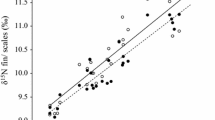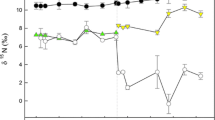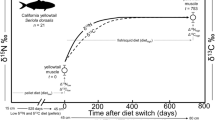Abstract
Nitrogen stable isotopes are frequently used in ecological studies to estimate trophic position and determine movement patterns. Knowledge of tissue-specific turnover and nitrogen discrimination for the study organisms is important for accurate interpretation of isotopic data. We measured δ15 N turnover in liver and muscle tissue in juvenile mummichogs, Fundulus heteroclitus, following a laboratory diet switch. Liver tissue turned over significantly faster than muscle tissue suggesting the potential for a multiple tissue stable isotope approach to study movement and trophic position over different time scales; metabolism contributed significantly to isotopic turnover for both liver and muscle. Nitrogen diet-tissue discrimination was estimated at between 0.0 and 1.2‰ for liver and –1.0 and 0.2‰ for muscle. This is the first experiment to demonstrate a significant variation in δ15 N turnover between liver and muscle tissues in a fish species.


Similar content being viewed by others
References
Abraham BJ (1985) Species profiles: life histories and environmental requirements of coastal fishes and invertebrates (Mid-Atlantic)—mummichog and striped killifish. In: Rep. USFWSB, vol 82 (11.40). US Army Corps of Engineers, p23
Bosley KL, Witting DA, Chambers RC, Wainright SC (2002) Estimating turnover rates of carbon and nitrogen in recently metamorphosed winter flounder Pseudopleuronectes americanus with stable isotopes. Mar Ecol Prog Ser 236:233–240
Currin CA, Wainright SC, Able KW, Weinstein MP, Fuller CM (2003) Determination of food web support and trophic position of the mummichog, Fundulus heteroclitus, in New Jersey smooth cordgrass (Spartina alterniflora), common reed (Phragmites australis), and restored salt marshes. Estuaries 26:495–510
Deegan LA, Garritt RH (1997) Evidence for spatial variability in estuarine food webs. Mar Ecol Prog Ser 147:31–47
DeNiro MJ, Epstein S (1981) Influence of diet on the distribution of nitrogen isotopes in animals. Geochim Cosmochim Acta 45:341–351
Fauconneau B, Arnal M (1985) In vivo protein synthesis in different tissues and the whole body of rainbow trout (Salmo gairdnerii R.). Influence of environmental temperature. Comp Biochem Physiol A 82:179–187
Fry B, Arnold C (1982) Rapid 13C/12C turnover during growth of brown shrimp (Penaeus aztecus). Oecologia 54:200–204
Fry B, Baltz DM, Benfield MC, Fleeger JW, Gace A, Haas HL, Quinones-Rivera ZJ (2003) Stable isotope indicators of movement and residency for brown shrimp (Farfantepenaeus aztecus) in coastal Louisiana marshscapes. Estuaries 26:82–97
Fry B, Sherr EB (1984) δ13C measurements as indicators of carbon flow in marine and freshwater ecosystems. Contrib Mar Sci 27:13–47
Gannes LZ, Martínez del Rio C, Koch P (1998) Natural abundance variations in stable isotopes and their potential uses in animal physiological ecology. Comp Biochem Physiol A,Mol Integr Physiol 119:725–737
Herzka SZ, Holt GJ (2000) Changes in isotopic composition of red drum (Sciaenops ocellatus) larvae in response to dietary shifts: potential applications to settlement studies. Can J Fish Aquat Sci 57:137–147
Herzka SZ, Holt SA, Holt GJ (2001) Documenting the settlement history of individual fish larvae using stable isotope ratios: model development and validation. J Exp Mar Biol Ecol 265:49–74
Hesslein RH, Hallard KA, Ramlal P (1993) Replacement of sulfur, carbon, and nitrogen in tissue of growing broad whitefish (Coregonus nasus) in response to a change in diet traced by δ34S, δ13C, and δ15 N. Can J Fish Aquat Sci 50:2071–2076
Hobson KA (1999) Tracing origins and migration of wildlife using stable isotopes: a review. Oecologia 120:314–326
Hobson KA, Clark RG (1992) Assessing avian diets using stable isotopes I: turnover of 13C in tissues. Condor 94:181–188
Jackim E, LaRoche G (1973) Protein synthesis in Fundulus heteroclitus muscle. Comp Biochem Physiol A 44:851–866
Johnson BM, Martinez PJ, Stockwell JD (2002) Tracking trophic interactions in coldwater reservoirs using naturally occurring stable isotopes. Trans Am Fish Soc 131:1–13
Kurle CM, Worthy GAJ (2002) Stable nitrogen and carbon isotope ratios in multiple tissues of the northern fur seal Callorhinus ursinus: implications for dietary and migratory reconstructions. Mar Ecol Prog Ser 236:289–300
Lotrich VA, Meredith WH (1974) A technique and the effectiveness of various acrylic colors for subcutaneous marking of fish. Trans Am Fish Soc 103:140–142
MacAvoy SE, Macko SA, Garman GC (2001) Isotopic turnover in aquatic predators: quantifying the exploitation of migratory prey. Can J Fish Aquat Sci 58:923–932
Martínez del Rio C, Wolf BO (2004) Mass-balance models for animal isotopic ecology. In: Starck JM, Wang T (eds) Physiological consequences of feeding. Springer, Berlin Heidelberg New York
Maruyama A, Yamada Y, Rusuwa B, Yuma M (2001) Change in stable nitrogen isotope ratio in the muscle tissue of a migratory goby, Rhinogobius sp., in a natural setting. Can J Fish Aquat Sci 58:2125–2128
McCutchan JH Jr, Lewis WM Jr, Kendall C, McGrath CC (2003) Variation in trophic shift for stable isotope ratios of carbon, nitrogen, and sulfur. Oikos 102:378–390
Millward DJ (1989) The nutritional regulation of muscle growth and protein turnover. Aquaculture 79:1–28
Minagawa M, Wada E (1984) Stepwise enrichment of δ15 N along food chains: further evidence and the relation between δ15 N and animal age. Geochim Cosmochim Acta 48:1135–1140
Peterson BJ, Fry B (1987) Stable isotopes in ecosystem studies. Annu Rev Ecol Syst 18:293–320
Post DM (2002) Using stable isotopes to estimate trophic position: models, methods, and assumptions. Ecology 83:703–718
Robins CR, Ray GC (1986) A field guide to Atlantic coast fishes of North America. Houghton Mifflin Company, Boston
Scarola JF (1987) Freshwater fishes of New Hampshire. New Hampshire Fish and Game Department, Concord, New Hampshire
Tieszen LL, Boutton TW, Tesdahl KG, Slade NA (1983) Fractionation and turnover of stable carbon isotopes in animal tissues: implications for δ13C analysis of diet. Oecologia 57:32–37
Tominaga O, Uno N, Seikai T (2003) Influence of diet shift from formulated feed to live mysids on the carbon and nitrogen stable isotope ratio δ13C and δ15 N in dorsal muscles of juvenile Japanese flounders, Paralichthys olivaceus. Aquaculture 218:265–276
Vander Zanden MJ, Hulshof M, Ridgway MS, Rasmussen JB (1998) Applications of stable isotope techniques to trophic studies of age-0 smallmouth bass. Trans Am Fish Soc 127:729–739
Vander Zanden MJ, Rasmussen JB (2001) Variation in δ15 N and δ13C trophic fractionation: implications for aquatic food web studies. Limnol Oceanogr 46:2061–2066
Vanderklift MA, Ponsard S (2003) Sources of variation in consumer-diet δ15 N enrichment: a meta-analysis. Oecologia 136:169–182
Zar JH (1984) Biostatistical analysis, 2nd edn. Prentice Hall, New Jersey
Acknowledgments
We thank B. Fry, S. Herzka, and S. Litvin for their comments on the initial design of this experiment. S. Bean provided additional editing of drafts of this manuscript. We thank C. Martínez del Rio and two anonymous reviewers for their helpful comments on drafts of this manuscript. C. Lawrence assisted in mummichog husbandry. E. Enos and J. Hanley coordinated our use of flowing seawater tables in the Whitman laboratory. R. Smolowitz supervised our animal care in the laboratory and A. Kuzirian reviewed our IACUC proposal. M. Otter performed all stable isotope analyses. C. Neefus provided consultation on statistical analyses. This study was funded by NSF LTER grant OCE-9726921. This experiment complies with current U.S. law, and organisms used in the experiment were handled according to IACUC protocol.
Author information
Authors and Affiliations
Corresponding author
Additional information
Communicated by Carlos Martinez del Rio
Rights and permissions
About this article
Cite this article
Logan, J., Haas, H., Deegan, L. et al. Turnover rates of nitrogen stable isotopes in the salt marsh mummichog, Fundulus heteroclitus, following a laboratory diet switch. Oecologia 147, 391–395 (2006). https://doi.org/10.1007/s00442-005-0277-z
Received:
Accepted:
Published:
Issue Date:
DOI: https://doi.org/10.1007/s00442-005-0277-z




